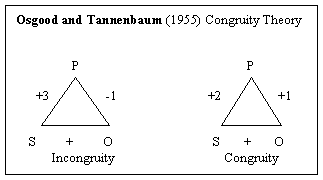Congruity Theory - Explained
What is Congruity Theory?
- Marketing, Advertising, Sales & PR
- Accounting, Taxation, and Reporting
- Professionalism & Career Development
-
Law, Transactions, & Risk Management
Government, Legal System, Administrative Law, & Constitutional Law Legal Disputes - Civil & Criminal Law Agency Law HR, Employment, Labor, & Discrimination Business Entities, Corporate Governance & Ownership Business Transactions, Antitrust, & Securities Law Real Estate, Personal, & Intellectual Property Commercial Law: Contract, Payments, Security Interests, & Bankruptcy Consumer Protection Insurance & Risk Management Immigration Law Environmental Protection Law Inheritance, Estates, and Trusts
- Business Management & Operations
- Economics, Finance, & Analytics
What is Congruity Theory?
Congruity Theory, proposed by Osgood and Tannebaum, is a model of attitude change that states when a person we like approves the same thing we are in sympathy with, there is congruity or congruence.
Further, when a person we like dislikes something we approve of, leads instead to an unbalanced relationship or a cognitive dissonance. This influences attitude changes.
The Congruity concept are very similar to its parent theory, Heider’s Balance Theory, which holds that when change in evaluation or attitude takes place, it always increases congruity with respect to the existing frame of reference.
How to Calculate Attitude Change?
The main contribution of Congruity Theory consists of a formula that allows one to calculate the amount and the direction of attitude changes.

Source (S) of information
Object (O) is the Concept
Perceiver or Person (P) is the Audience
A typical situation of Congruity Theory is:
(S) makes a statement about a (O), that can be either positive (associative) or negative (dissociative), and (P) has attitudes toward both (S) and (O).
Note: What a Source states about a Object is the only element that cannot vary.
The relationship between P and S and P and O is measured on a 7 point scale. + is a positive association . - is a negative association.
As such, these metrics demonstrate the extent to which negative information affects the perception of the Source of the statement and the Object of the statement.
In other words, it helps to predict how much the attitudes of the audience may vary with respect to source and concept (i.e. if an audience considers a source reliable, interesting and attractive there is congruity, so there is no push to attitude change).
Osgood and Tannenbaum’s Congruity Theory is the strong orientation to communication and persuasion.